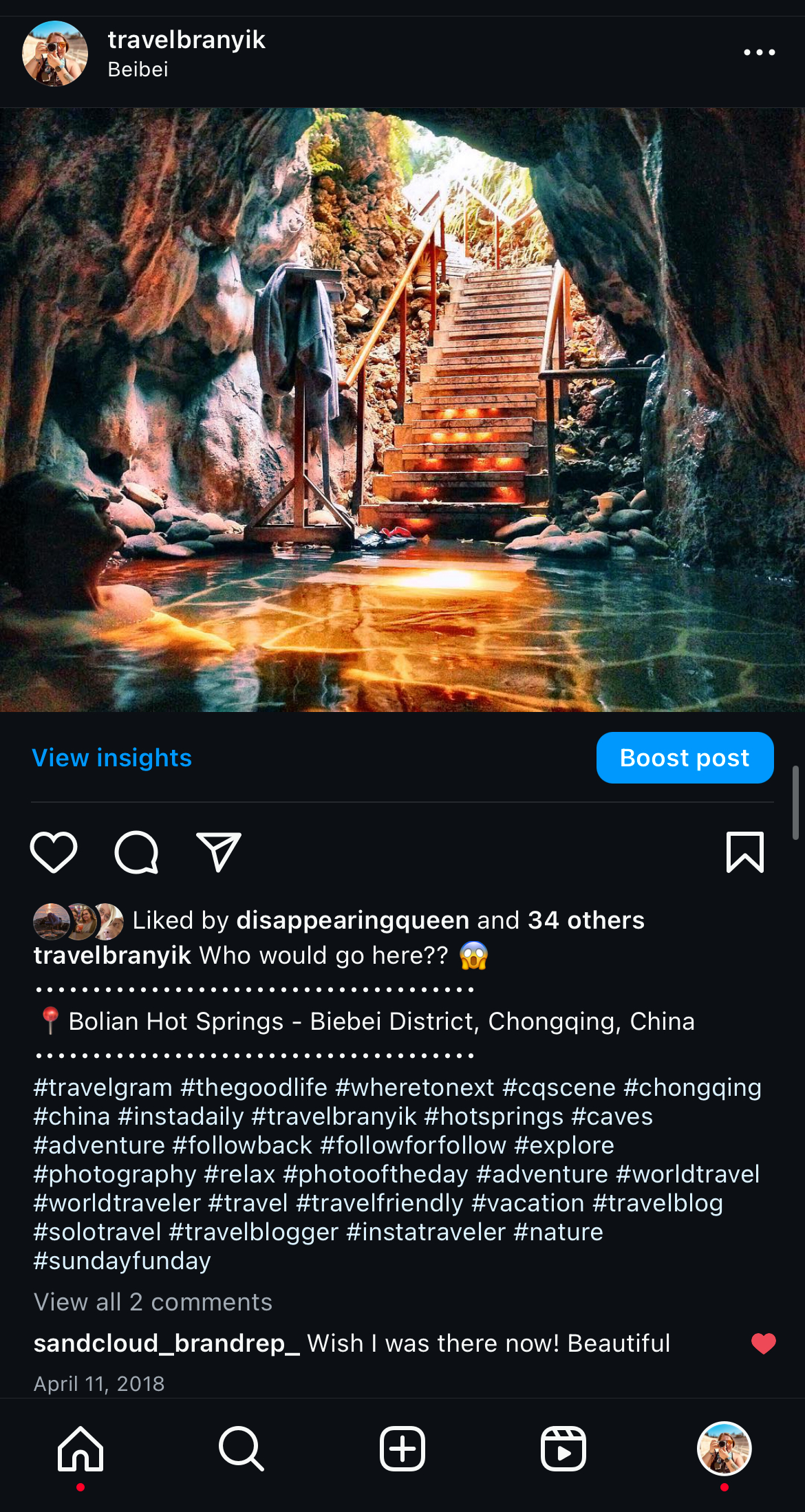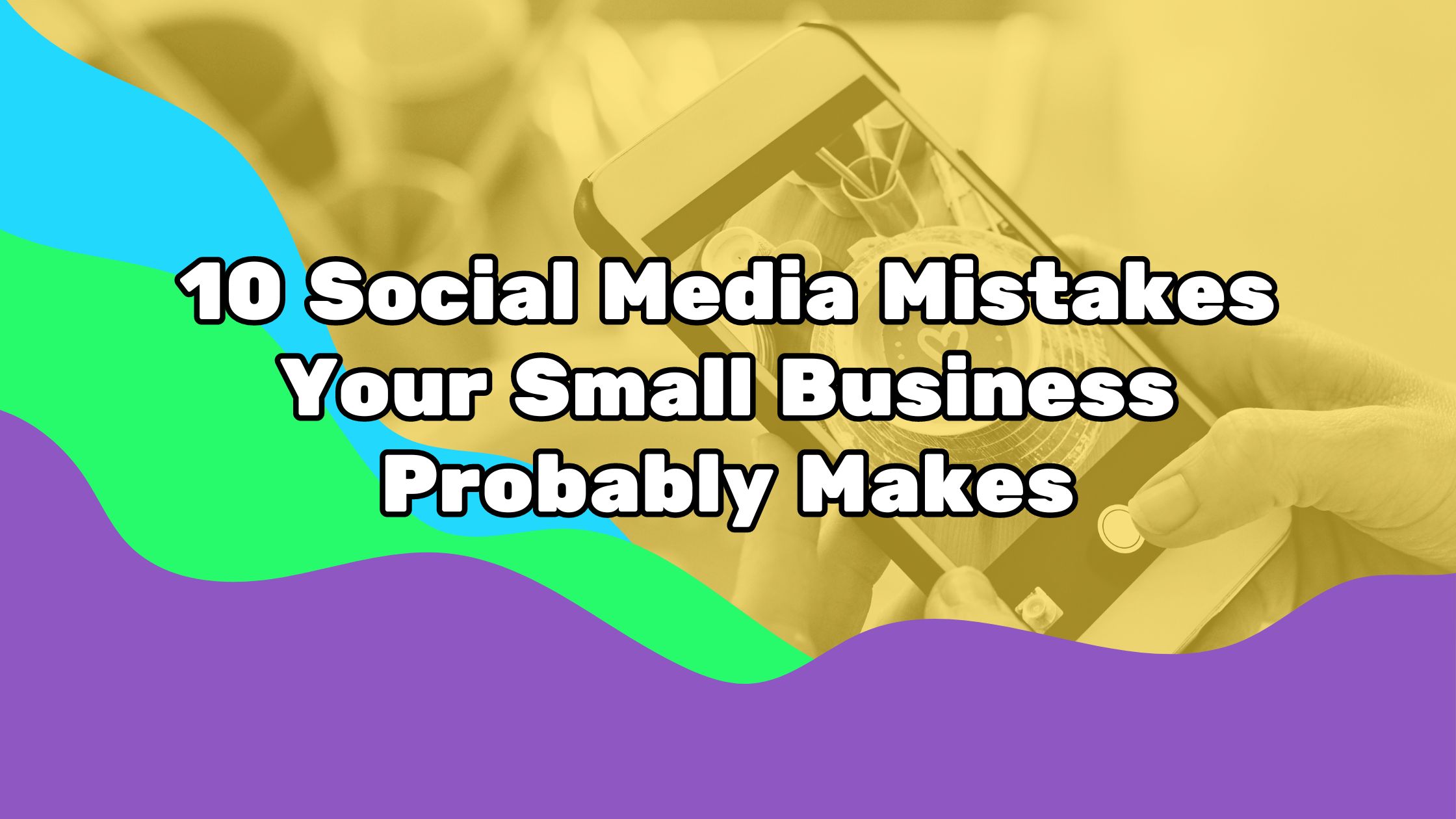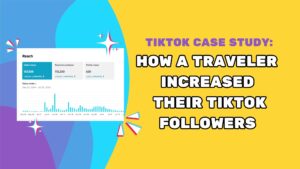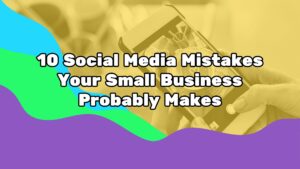Social media is a powerful tool for small businesses to connect with their audience, build brand awareness, and drive sales.
But it’s not surprising to know that many small businesses fall into common traps that hinder their social media success.
These are the top 10 social media mistakes small businesses make on and how to avoid them.
1. Poor Image or Video Quality

High-quality visuals are essential in capturing your audience’s attention. Poor-quality images or videos can reflect poorly on your brand and make you look unprofessional
Social video, for example, gathers as much as 1200% more engagement than image and text posts combined.
According to Neil Patel, investing in good photography and videography equipment or hiring a professional can significantly improve engagement rates.
Tips For Creating High-Quality Visuals
Stepping up your visuals game may seem like a lot, but after you get the hang of it, it’s an easy part of making your small business shine. So avoid this social media mistake with these helpful tips on enhancing visuals.
- Invest in Good Video and Photography Equipment: A phone can do the trick in a pinch, especially with video, but if you notice your videos are playing at 720 resolution, you might be losing people. Invest in a camera that shoots in 1080p or 4K to really stand out.
- Use Editing Tools: Tools like Canva, Adobe Express, and CapCut are great for creating professional-looking visuals without breaking the bank. Canva will be your best friend when it comes to creating on-brand visuals, and if you’re not confident in utilizing it, try any of their courses to up your skills.
- Consistency in Style: Maintaining your brand identity is ultimately what makes your business recognizable. So use your brand colors, fonts, and filters across all your social media platform visuals.
- Optimize for Each Platform: The biggest social media mistake we often see is businesses who post the same content (hashtags and all) on Facebook Each social media platform has different requirements and best practices for visual content. Ensure your images and videos are optimized for the specific dimensions and formats of each platform to avoid cropping or distortion. For example, Instagram favors square images, while Facebook and Twitter often perform better with landscape-oriented visuals.
- Attention to Detail: Lighting, composition, and background are critical details you should always pay attention to. Good lighting can dramatically improve the quality of your images and videos, while a clutter-free background keeps the focus on your subject. Composition techniques like the rule of thirds can make your visuals more appealing and engaging.
Follow these tips and you can bring your social media from okay to great!
2. Not Posting at Peak Times

Timing is crucial when it comes to social media posts. Posting when your audience is most active increases the likelihood of engagement. Not using analytics tools to identify peak times for your specific audience is one of the big social media mistakes business owners often make.
Each platform has different peak times, so tailor your posting schedule accordingly.
Hit the open road with confidence. These motorcycle saddlebags are as reliable as your ride.
How to Know When To Post
No one account will be the same, so it’s important to pay attention to your metrics when understanding when your audience is online. Sprout Social gives a great breakdown of when to post on each platform.
But here are some other ways to discover optimal posting times:
- Analytics Tools: Utilize tools like Facebook Insights, Instagram Analytics, and Twitter Analytics to track when your followers are most active. Not all tools examine all social platforms.
- Platform Guidelines: Refer to general peak times for each platform, but prioritize your analytics data
- Experimentation: Try testing different times and tracking engagement to refine your posting schedule
- Consistency: Regularly review and adjust your posting times based on ongoing data
With these helpful tips, you may see an increase in social media engagement. Pay attention to which posts have the highest performance and create more similar posts.
3. Non-Optimized Content
Creating content that’s not optimized for each platform’s specifications can result in lower engagement and visibility.
And more important than ever, it’s crucial to keep content mobile-friendly. With a significant portion of users accessing social media through their smartphones, content that isn’t optimized for mobile can lead to poor user experience, such as slow loading times or difficult-to-read text.
Tips for Optimizing Your Social Content
It’s crucial to tailor your posts to fit the unique requirements of each social media site. This includes:
- Using the correct image sizes
- Using proper video formats
- Abiding the character limits for each platform
Social platforms like Instagram favor square or portrait images with a high resolution. Twitter, on the other hand, is optimized for landscape images and shorter videos. LinkedIn prioritizes longer, more detailed posts that cater to a more professional audience.
Neglecting these nuances can make your content appear poorly formatted or cropped, reducing its impact and shareability.
Always test your content on mobile devices to ensure it displays correctly and maintains a good user experience.
4. Improper Use of Hashtags

Hashtags are a powerful tool to boost the visibility of your posts, but improper use can backfire. Major brands have made big mistakes when using hashtags that aren’t relevant, and small businesses can learn from their mistakes.
Have you ever seen people on Instagram adding 30 hashtags to their posts that you then see posted to Facebook? This is a common practice that was promised to work a few years ago, but as we know, trends change.
Now, having a boatload of hashtags or using irrelevant hashtags can harm your social media strategy.
How To Properly Utilize Hashtags
To better utilize hashtags in your strategy, here are key points to consider for effective hashtag usage:
- Research Relevant and Trending Hashtags: Use relevant hashtags that resonate with your target audience. Research currently trending hashtags in your niche and pay attention to ones that consistently attract engagement.
- Mix Popular and Niche-Specific Hashtags: A balanced approach to hashtagging can broaden your reach. Popular hashtags with high volumes can expose your content to a wider audience, while niche-specific hashtags with lower volumes can connect you with a more targeted, engaged community. This combination can help you attract both broad and specific interest in your posts.
- Avoid Overloading with Hashtags: As tempting as it is to use as many hashtags as possible, this strategy makes your content appear spammy and unprofessional. Use a moderate number of hashtags—typically 5 to 10—depending on the platform. For example, Instagram allows up to 30 hashtags, but studies show that engagement can drop after using more than 10.
- Use Hashtags Strategically: Be thoughtful about where you add hashtags in your post. On platforms like Instagram, it’s common to place hashtags at the end of the caption or in a separate comment to keep the post looking clean. On platforms like Twitter, incorporate them naturally within your tweet to maximize character space.
- Regularly Update Your Hashtags: Trends are always, always changing. As a result, their effectiveness can also change. Be sure to regularly review and update your hashtag strategy so you’re always using the most relevant and effective tags for your content.
Understanding and implementing these best practices can help you improve reach and discoverability while giving off the impression that you’ve been doing social for years.
5. Lack of Consistency and Posting Frequency

Consistency is crucial in building and maintaining your audience’s interest and trust. One of the biggest social media mistakes small businesses make is posting at random and have long silent periods between posts.
So what’s the difference between frequency and consistency?
Posting frequency is how often you publish content on your social media platforms. This could be daily, weekly, or multiple times per day. Posting consistently is the act of maintaining a regular and predictable schedule for your posts.
While posting frequency is about the number of posts, posting consistently focuses on the regularity and timing, ensuring that your audience knows when to expect new content.
How To Establish Posting Frequency and Consistency
Sporadic posting can lead to a disengaged audience which makes it difficult to grow your social media presence. To avoid this, it’s essential to establish a regular posting schedule. This doesn’t mean you have to post everyday, it just means you have establish a posting frequency and post consistently.
Here’s how to do that:
- Create a Content Calendar: Creating a content calendar helps organize your posts, ensuring a steady stream of content across your social media platforms. It allows you to schedule posts around key dates, holidays, or industry events, making your content more relevant and timely.
- Use Automation Tools: To maintain consistency, consider using tools like Later, Hootsuite, Semrush Social, or Buffer. These platforms allow you to schedule posts ahead of time, ensuring your content goes live at optimal times, even when you’re busy. Automation tools can also help you manage multiple social media accounts and help you customize each post for each platform.
- Maintain a Balanced Posting Frequency: While consistency is key, it’s also important to balance posting frequency with posting consistency. Posting too often can overwhelm or fatigue your audience, while infrequent posts can lead to reduced visibility. Monitor your audience’s engagement patterns to determine the best posting frequency for each platform. For instance, Twitter may require more frequent updates than LinkedIn or Instagram.
- Adapt to Platform-Specific Needs: Different platforms have different norms and expectations for posting frequency. For example, you might post daily on Instagram but only a few times a week on LinkedIn, depending on your audience’s preferences and the nature of your content.
- Monitor and Adjust: Regularly review your analytics to understand which posting frequencies work best for your audience. Be open to adjusting your schedule based on performance data and audience feedback.
The best way to maintain consistency and frequency is to pick one day out of your week to create and schedule posts. This can give you a broader view of what’s coming up and keep your posting strategy in line so you’re not over or under promoting your business.
This approach can help maintain your brand’s visibility and keep your followers coming back for more.
6. Posting the Same Content to All Platforms

Each social media platform caters to a unique audience with specific expectations and content styles, which means what you post on Instagram shouldn’t be what you post on Facebook.
Posting the same content across all platforms without customization can be ineffective and may even appear lazy, and it’s easy to spot amongst marketers.
Tips For Ensuring Your Content is Unique on All Platforms
As a best practice, you should always tailor your content to suit the strengths and preferences of each platform, enhancing engagement and relevance.
- Understand Platform-Specific Nuances: All social platforms you’re used prioritize different types of content. Instagram is best for high-quality images and short videos. LinkedIn is more professional and content-driven, often emphasizing articles, industry insights, and professional achievements. Twitter requires more concise and impactful messaging that taps into trending hashtags.
- Adapt Content for Each Audience: Tailoring content means considering each platform audience’s unique demographics and preferences. Younger audiences on TikTok tend to engage more with short, creative videos. Facebook’s diverse user base might appreciate a mix of articles, images, and community-focused posts. Noting these differences allows you to craft diverse messages that resonate more deeply with each audience segment.
- Leverage Platform Features: Each social media platform offers distinct features that can enhance your content’s effectiveness. For Instagram, it’s things like Stories and Reels. For LinkedIn, it’s Pulse for publishing longer articles. As for platforms like Twitter, content must be sharp and to-the-point.
- Maintain a Consistent Brand Voice: Adapting content to each platform is just one piece of the social puzzle. Maintaining a consistent brand voice and message across all channels is crucial for every business. This consistency helps build brand recognition and trust, even as you tailor your content to fit various formats and audiences.
- Monitor and Analyze Performance: Analyze metrics such as engagement rates, shares, and audience feedback to refine your social media strategy. Data can inform your decision making and help you understand which content performs best on each platform. From there, you can create more of the posts that work and leave other less engaging posts behind.
It’s not uncommon to post the same video or image across social platforms. This is not an issue! The issue lies in accompanying content. If the content isn’t customized for each platform, you mind find it difficult to engage with the audience.
7. Wasting Time on All Platforms
Not every social media platform will be advantageous for your business, and that’s okay!
Maintaining a presence on too many platforms can spread your resources thin and dilute your overall effectiveness. Instead, it’s more strategic to concentrate your efforts on the platforms that offer the most significant potential for engagement and growth.
To avoid spending your time in the wrong areas, do some research on your customers and their demographics to determine which platforms is best for you.
How To Determine the Best Social Platforms For Your Business
There’s no one way to discover which platform is best for you, but here are a few avenues to take to find where to spend your time and energy.
- Identify Your Target Audience’s Preferred Platforms: Conducting audience research can reveal which platforms are most popular among your ideal customers. For example, a younger demographic might be more active on Instagram and TikTok, while a professional audience may prefer LinkedIn.
- Focus on High-Impact Platforms: After identifying the key platforms for your audience you’ll have an easier time allocating your resources accordingly. Placing focus on a few high-impact platforms gives you more time to run your business and create quality content that resonates with your audience. This targeted approach can lead to better engagement and a stronger brand presence.
- Quality Over Quantity: Having a strong presence on a few platforms is better than having a weak presence on many. Concentrating your efforts helps ensure your content is high quality, tailored to the platform, and engaging. As a result, you’ll build a more loyal following and maximizes the ROI on your social media efforts.
- Monitor Performance and Adjust: We cannot stress this enough. Review your analytics regularly. If certain platforms are underperforming even with consistent posting, you may find more results in focusing on successful channels. Ongoing evaluation also keeps you agile and responsive to any changes in your audience’s behavior and preferences.
- Avoid the “Everywhere” Syndrome: While it might seem beneficial to have a presence on every social media platform, this can lead to a scattered and unfocused strategy. Instead, aim for depth and engagement on select platforms where you can make the most impact. This focused approach not only conserves resources but also strengthens your brand’s identity and messaging.
At the root of it all, you want to always focus on quality over quantity.
If you’re a boutique clothing store, chances are you’re not going to be using Twitter to reach your audience. Visual platforms like Instagram, TikTok, and Pinterest will probably be the best platforms for you. If you’re a consulting business, LinkedIn will be your pride and joy.
Focusing your approach ensures your efforts are effective and aligned with your business objectives.
8. Ignoring Engagement and Interaction
Social media isn’t just for broadcasting your message; it’s also a platform for building relationships with your audience. In fact, that’s the heart of every social media platform.
You’re not likely to build a loyal following if you’re ignoring comments, messages, or mentions. Doing so can create a sense of disconnect and lead to a disengaged audience.
If you’re a business that get’s a lot of engagement, but doesn’t respond to comments, you may see your engagement start to go down. Also, engaging with followers can drastically increase your reach. So what’s not to love about interacting?
How To Keep Your Audience Engaged on Social
Here’s some things to remember when it comes to interacting with your followers:
- Responding to Comments and Messages: Acknowledge and reply to comments and messages promptly, showing that you value your audience’s input and opinions.
- Participating in Conversations: Engage in discussions relevant to your brand or industry, both on your posts and on other users’ content. This helps establish your presence and authority in your niche.
- Showing Appreciation: Express gratitude to your followers for their support, whether through shout-outs, giveaways, or simply thanking them for their engagement.
These interactions help foster loyalty, create a sense of community, and make your audience feel valued and connected to your brand.
9. Focusing Too Much on Promotion
While promoting your products or services is an essential aspect of social media marketing, an excessive focus on promotional content can alienate your audience and it is probably one of the top social media mistakes amongst businesses.
Constantly pushing sales or promotions can come across as insincere or overly commercial, potentially driving followers away.
It’s crucial to strike a balance to keep your audience engaged and interested in your brand.
Tips for Balancing Entertaining Content with Promotional Content
- The 80/20 Rule: the 80/20 rule is a great guideline for content distribution. This means 80% of your content should be informative, entertaining, or educational. This type of content can include tips, tutorials, industry news, behind-the-scenes glimpses, or engaging stories that resonate with your brand’s ethos. The other 20% of your content can be focused on promoting you product and brand.
- Subtle Promotion: When it comes time to promote your products or services, do so subtly and strategically. Ensure that promotional posts are well-crafted, highlighting the benefits and features in a way that appeals to your audience’s needs and interests. Integrating promotional content with storytelling or customer testimonials can make it feel more authentic and relatable.
- Monitor Audience Feedback: Pay attention to how your audience responds to different types of content. Use analytics tools to track engagement rates, shares, and comments, and adjust your content strategy accordingly. If you notice a drop in engagement during periods of heavy promotion, it may be a sign to dial back and refocus on providing value.
- Create a Content Mix: A diverse content mix including educational posts, inspirational stories, user-generated content, and occasional promotional posts can keep your feed interesting and engaging. It also caters to different aspects of your audience’s interests and preferences.
These approaches to balancing educational and promotional content helps in building a strong and engaged community and also enhances the effectiveness of your promotional efforts.
10. Neglecting Analytics

One of the most critical social media mistakes small businesses make on social media is neglecting their analytics. Without tracking and analyzing your social media performance, you miss out on valuable insights that can inform your strategy and improve your results. This oversight can lead to wasted resources, ineffective content, and missed opportunities for engagement and growth.
Analytics provide a wealth of information about your audience’s behavior, preferences, and engagement patterns. By regularly reviewing this data, you can gain a deeper understanding of what resonates with your audience, identify trends, and make data-driven decisions to optimize your content and strategies.
Key Social Media Metrics to Track
- Engagement Rates: Metrics like likes, comments, shares, and reactions indicate how well your content resonates with your audience. High engagement rates suggest that your content is compelling and relevant, while low engagement may indicate a need for adjustments.
- Reach and Impressions: These metrics show how many people have seen your content and how often it’s been displayed. They help you understand the overall visibility of your posts and whether your reach is expanding.
- Audience Demographics: Understanding the demographics of your audience, such as age, gender, location, and interests, allows you to tailor your content to better meet their needs and preferences.
- Conversion Rates: If your social media strategy includes driving traffic to your website or encouraging specific actions, tracking conversion rates is crucial. This metric shows how many users took the desired action, such as signing up for a newsletter or making a purchase, after interacting with your content.
- Content Performance: Analyzing which types of content perform best can guide your content creation efforts. For example, you may find that videos generate more engagement than images, or that posts with certain themes are more popular.
You can leverage tools Google Analytics, Facebook and Instagram Insights, and Twitter or TikTok Analytics to gain valuable insights into your audience’s behavior and preferences. From there, you can refine your strategies and improve your results.
The Best Social Media Tools for Small Businesses
Not every tool will work for every business, but there are a few cost-effective tools you can utilize to guide you on the path to social media success. We’ve tried most of the big ones and here’s the ones we recommend.
- Canva: Crucial for any good social media design
- CapCut: The easiest video editing tool for beginners who still want to make great videos for Instagram, TikTok, and YouTube
- Semrush or Ahrefs: A critical tool for helping with keyword research and competitive analysis
- Later: this is one of the most cost effective social media posters out there. While it focuses a lot on Instagram first, you can connect multiple profiles for multiple businesses and schedule out posts to save time.
Avoid Further Social Media Mistakes. Join Our Social Media Masterclass!
Avoiding these common social media mistakes can significantly enhance your online presence and engagement. However, managing a successful social media strategy requires time, effort, and expertise.
At Little Wave Media, we specialize in helping small businesses navigate the complexities of social media marketing. Our tailored solutions ensure your brand stands out and connects with your audience effectively.
Contact us today to see how we can elevate your social media game and drive your business forward.








